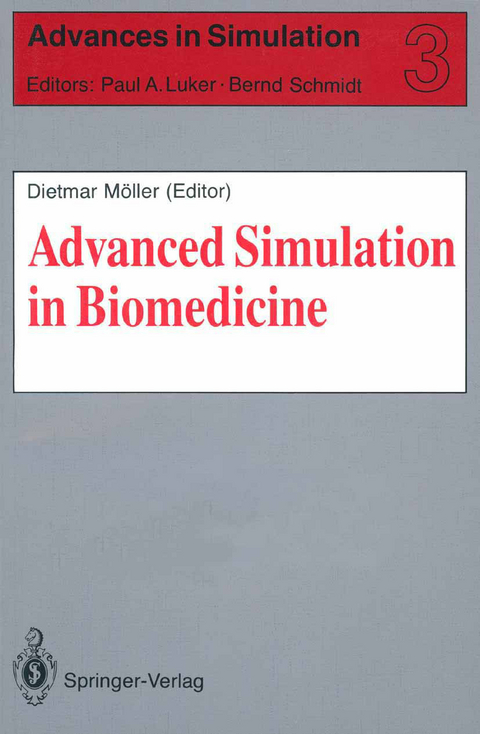
Advanced Simulation in Biomedicine
Springer-Verlag New York Inc.
978-0-387-97184-1 (ISBN)
This book presents a collection of invited contributions, each reflecting an area of biomedicine in which simulation techniques have been successfully applied. Thus, it provides a state-of-the-art survey of simulation techniques in a variety of biomedical applications. Chapter one presents the conceptual framework for advanced simulations such as parallel processing in biological systems. Chapter two focuses on structured biological modeling based on the bond graph method. This is followed by an up-to-date account of advanced simulation of a variety of sophisticated biomedical processes. The authors provide many insights into how computer simulation techniques and tools can be applied to research problems in biomedicine. The idea for this book arose out of the daily work by experts in their field and reflects developing areas. Therefore, I think the material is timely and hope that the work described will be an encouragement for others. It is the objective of this book to present advanced simulation techniques in biomedicine and outline current research, as well as to point out open problems, in this dynamic field. Finally, I wish to express my thanks to those colleagues who have made this book possible with their contributions.
Parallel Processing in Biological Systems.- Multicomputers in simulation.- Evolution in simulation oriented digital computers.- Classification of multicomputers.- Parallel simulation.- Simulation of biological systems and its need for parallel processing.- Simulation example on the AD10 multicomputer.- Concluding notes.- References.- An Elementary Bond Graph Approach to Structured Biological Modeling.- The need for unified graphical structured modeling.- General lines of the presentation.- Bond graph representation of energetical systems.- Hypergraph representation of energetical lumped systems.- The set EP of elementary parts or nodes.- The two elementary connection branches.- Bond graphs: A representation of a subclass of energetical hypergraphs.- The chemical energy domain.- Chemical EBG variables and energy storage elements.- Chemical reaction and dissipation by R-elements based on mass action.- The pseudo bond graph approach to reaction kinetics and compartments.- Representation of kinetic and potential energies by dynamical bond graphs.- Algorithmic representation of idealized physical models by bond graphs.- The EBG representation of an electrical IPM.- Representation algorithms for other systems.- Coupling of bond graphs and informational block diagrams.- Representation of information transfer in BG’s by active bonds.- Coupling of active bonds to BG nodes.- Formulation algorithms: Automatic obtention of simulation routines.- The causal stroke: A graphical marker of causality.- Sequential assignment of causality for elements and junctions.- Algorithmic derivation of the procedural simulation routine.- Conclusion.- References.- Simulation of Typical Physiological Systems.- Recent advances in digital computing.- Success may cause trouble.- Other issues.- Atypical physiological model.- Non-linear relationships.- Algebraic relationships.- Integral relationships.- Summary.- References.- Parameter Estimation: An Advanced Simulation Tool in Biomedicine.- Model building of the renovascular system.- Parameter estimation.- Identification task.- Identification results.- References.- A Review of Respiratory System Applications of Computer Simulation and Modelling Techniques.- Physiological background.- The conceptual basis of modelling the system.- Modelling and simulation as research tools.- Simulation for teaching.- Simulation in respiratory gas exchange teaching.- The MacPuf model.- A computer simulation for training in anaesthesia.- Estimation techniques involving system identification methods.- Applications involving gas exchange models.- Lung mechanics models.- Models for on-line control.- Discussion.- References.- Computer Simulation in Cancer Research.- The cancer problem.- Biological observations of cell growth.- Growth of normal cells.- Growth of tumor cells.- Possibilities of cancer treatment.- Statement of the modeling problem.- Overview of previous work.- Model design.- Fundamental components.- Limitations.- Computer-implementation of the model.- Simulation results and discussions.- Formation of capillaries.- Spread of tumor cells in the cortex.- Tumor angiogenesis effect.- Outlook.- References.- Mathematical Simulation of the Human Thermal System.- Distributed parameter model: Radial dependencies.- Distributed parameter model: Three dimensional dependencies.- Data base.- Physics and mathematics of the passive system.- Metabolic heat production.- Convective heat transport.- Controller equations.- Numerical solution.- Results of simulation.- Distribution of temperatures and profiles in neutral environment.- Control strategy.- Temperature profiles in the cold and in the warmth.- References.- Large-Scale Multiple Model for the Simulation of Anesthesia.- Concept of the large-scale multiple model.- Model design.- Composition of the anesthesia model.- Hemodynamic submodel.- Compartmental transport model.- Baroreceptor control submodel.- Pharmacodynamic submodel.- Simulation results.- Conclusions.- References.
| Reihe/Serie | Advances in Simulation ; 3 |
|---|---|
| Zusatzinfo | 18 Illustrations, black and white; XI, 203 p. 18 illus. |
| Verlagsort | New York, NY |
| Sprache | englisch |
| Maße | 155 x 235 mm |
| Themenwelt | Informatik ► Grafik / Design ► Digitale Bildverarbeitung |
| Mathematik / Informatik ► Informatik ► Theorie / Studium | |
| Medizin / Pharmazie ► Medizinische Fachgebiete ► Biomedizin | |
| Medizin / Pharmazie ► Physiotherapie / Ergotherapie ► Orthopädie | |
| Naturwissenschaften ► Biologie | |
| Sozialwissenschaften ► Soziologie | |
| Technik ► Medizintechnik | |
| ISBN-10 | 0-387-97184-X / 038797184X |
| ISBN-13 | 978-0-387-97184-1 / 9780387971841 |
| Zustand | Neuware |
| Haben Sie eine Frage zum Produkt? |
aus dem Bereich


